Managing projects in iSpring
Learn how to manage your projects when creating e-Learning courses or presentations with iSpring authoring tools. It’s important to know about the project functionality in iSpring before you start working on complex courses, recording audio or video, creating quizzes or adding other resources to your project.
In this article
- What is a project ↓
- Choose the right place for your project ↓
- The structure of the project folder ↓
- Output folder ↓
- Backups and collaborative work ↓
What is a project
A project in iSpring is a combination of your original PowerPoint presentation file and the respective project folder that stores your project files (narrations, quizzes, etc.). iSpring creates this folder automatically when you add something by means of iSpring, and gives it the same name as your .pptx file.
Desktop iSpring products are PowerPoint-based authoring tools, which means that you start working with a PowerPoint presentation, supplement it with narrations and interactive objects, and publish it to a web-ready format, so it can be played in a web browser.
Creating a project is so natural that you don’t even recognize the moment of its creation. Every time you open a .pptx file and switch to an iSpring tab, it becomes an iSpring project.
This is how your project looks in Windows Explorer:
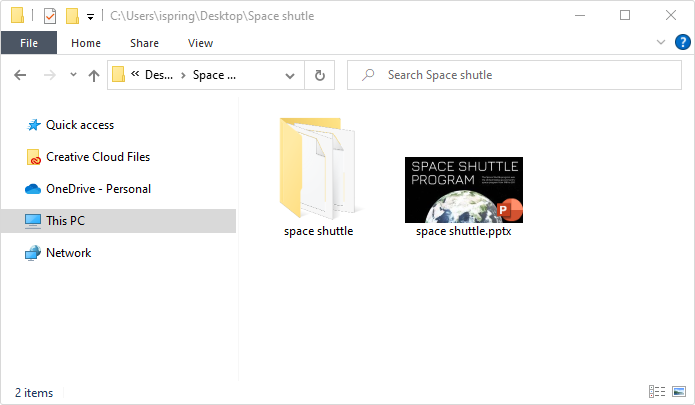
You can work on your project, zip it, and send it to a colleague as a part of collaborative work, or make a backup copy to ensure the safety of your data.
Tip: We recommend that you put every PowerPoint presentation that will become an iSpring project into a separate folder. This method of file organization will make your experience with iSpring fitter, happier and more productive. Otherwise, you have a risk of losing your project folders.
Choose the right place for your project
Sel ect the right place to work on your projects. It must be the main storage of your computer (HDD or SSD), C:\ or D:\ logical drive.
The default location is C:\Users\%username%\Documents\Presentations, but you can create any other folder for your iSpring Projects in your Documents or another user folder. You must have full access (read, write) to the folder where you store your projects. There should be plenty of free space on your drive for recording audio and video.
iSpring project folder tree
Take a look at the tree structure below to see how you can organize two or more projects:
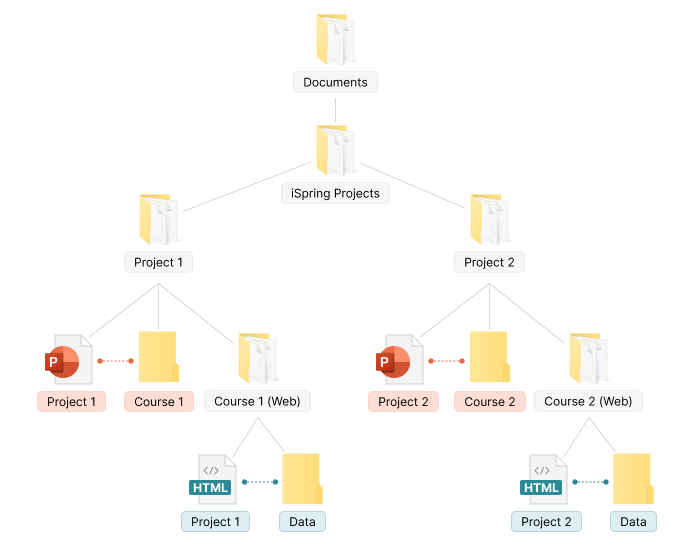
It would be best to locate every project in a separate folder (Project 1, Project 2). You can see the dashed links between project’s components and the published components (on the bottom level).
Closed folders on this scheme are not supposed to be manually managed. Any manual changes done to them (like renaming, moving, or deleting files inside the folder or the folder itself) can cause the connection between the elements to be lost. Use the PowerPoint to make changes to the project.
Other places to store projects
Fast USB drives can be carefully used, but it may cause some problems with lost project folders. Use external drives for storing large media files, backups and documents.
Network locations are not recommended because they have slower access time, and can cause conversion issues or errors while saving the project. An example of an Ethernet location: \\JOHN\
Microsoft OneDrive, and other shared drives can store .pptx files and other documents, but cannot be used for storing iSpring project folders safely.
The structure of the project folder
The project folder is automatically created when you click on any of these buttons on the iSpring toolbar: Resources, Record Audio/Video or Manage Narration, ins ert a Quiz, Interaction, Role-play, Screen Recording or a third-party Web Object. This additional information cannot be saved in a PowerPoint file, and therefore goes to this folder. It is given the same name as your PowerPoint presentation (as in the picture above).

Don’t open this folder, rename it or delete it, unless you know exactly what you are doing. Learn more in the Troubleshooting section for managing projects.
This is how the content of your project is organized inside this folder:
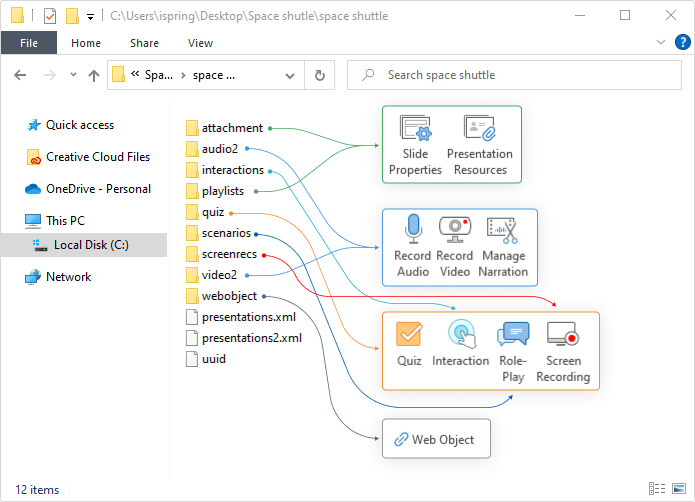
Audio
You can record an audio narration with iSpring. Here is a preview in the Manage Narration window:

The source audio is stored as uncompressed .wav audio files inside the "project_folder_name\audio2\files" folder:
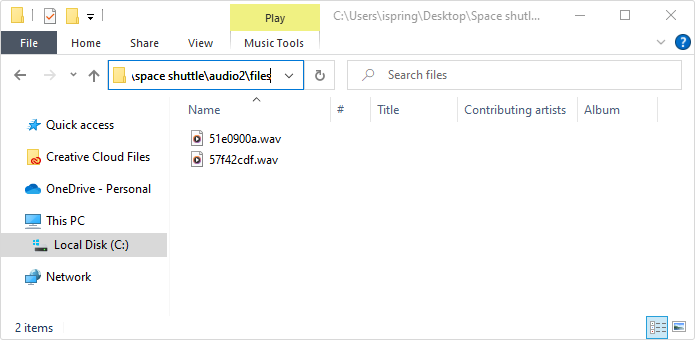
If you import a sound file in any compatible format (e.g., .mp3 or .wma), it is also saved in to this folder (without any additional compression).
The file names are generated randomly using letters and numbers [a-f, 0-9]. This is an internal automatic hex naming format, and there is no way to apply a custom naming scheme (e.g., audio01.wav, audio02.wav, etc.). If you need to find a specific source file, apply file sorting by the Date created column in Windows Explorer. It will list the audio files in their chronological recording order.
On the upper level, there are folders with description .xml files that store the audio file timings and modification instructions you apply when you edit the audio in the iSpring Audio Editor (opens by clicking on the Edit Clip button on the Manage Narration toolbar). For example, if you crop the audio in the editor, the source file stays unchanged, but the .xml file gets a modification instruction for this audio file.
Post-processing with third-party tools
If you need to apply any advanced post-processing to your source audio using some external tools (e.g., Audacity), perform the following steps:
-
Copy the source files to another location (e.g. to your “Documents\Audio post-processing” folder).
-
Modify your files with a 3rd-party editing tool.
-
Delete the old audio in your Manage Narration window.
-
Import the new reworked audio back to the iSpring Manage Narration window.
It’s recommended that you don’t change the length of the audio files and their bitrate, otherwise it may require re-syncing the new audio to the original slides.
Video
Video projects can be arranged the same way as audio. Here is a video preview in the Manage Narration window:
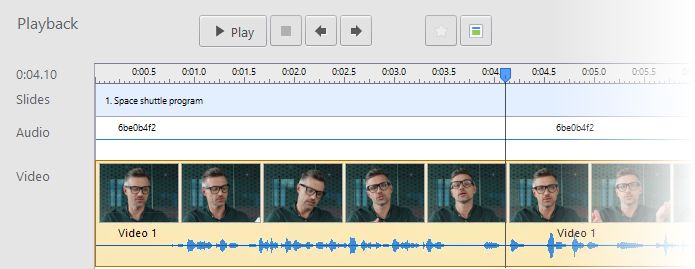
Videos are stored in the respective "project_folder_name\video2\" files folder:
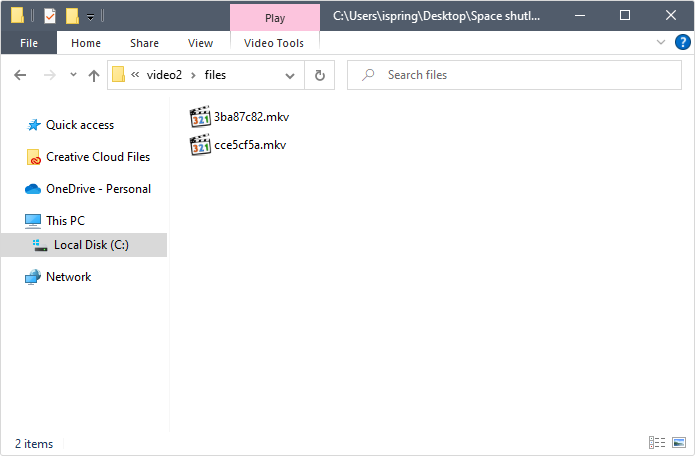
If you import a video file in any applicable format (e.g., .mp4 or .avi) it is also saved as is inside this folder (without any additional compression).
The upper level "project_folder_name\video2\" stores folders with description .xml files containing file timings and modification instructions fr om the iSpring Video Editor (opens by clicking on the Edit Clip button on the Manage Narration toolbar).
If you need to post-process your videos, use the same method as for audio.
Quizzes
Below is a quiz added on one of the slides of the PowerPoint presentation (by clicking the Quiz button):
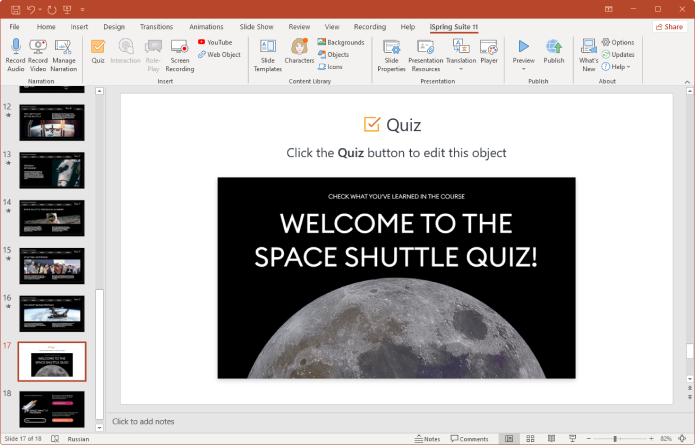
The source file for this quiz is stored inside the project_folder_name\quiz folder. Once created, every quiz is automatically given a sequential name (e.g., quiz1.quiz, quiz2.quiz, etc.).
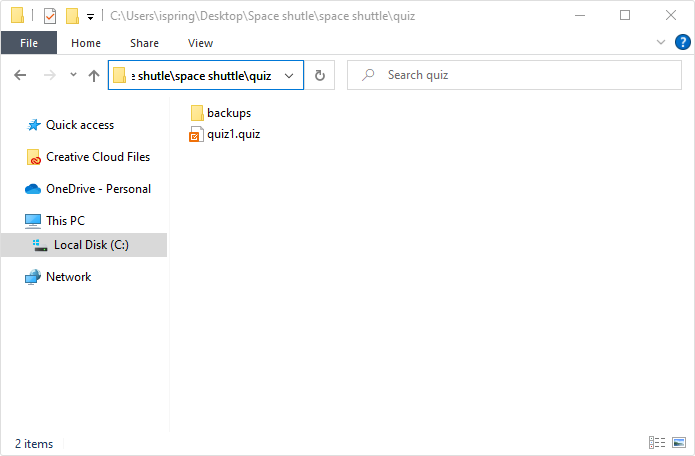
If you import a quiz to this presentation, it will also be copied to the project folder and given the automatic name.
Tip: If you have a number of quizzes that you share among many presentations (courses), it’s recommended that you create them using standalone QuizMaker and save to a dedicated folder (e.g., “Documents\iSpring Quizzes”). This way they will have distinctive names (not automatic). Import quizzes to your courses prior to publishing.
You can also export your embedded Quizzes using the Export function when editing:
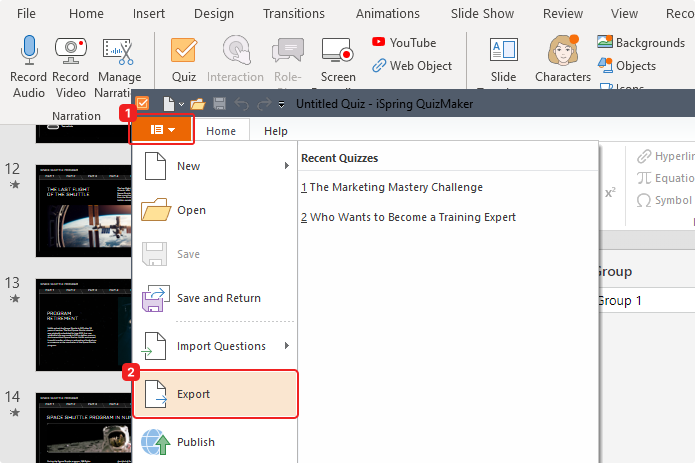
What’s stored in the PowerPoint file
There are some actions with the iSpring toolbar that don’t create a project folder. If you ins ert a Character, a Slide Template or a YouTube video,, they become a part of the .pptx file. Also, some settings that you adjust in the Publish, Presentation Explorer and Presenters dialog windows will be saved to the system folder and the PowerPoint file.

Also, the .pptx file stores the publishing settings for your project and the path to the project folder.
A PowerPoint presentation may contain Audio or Video that you add using PowerPoint’s Insert tab on slides (don’t confuse with iSpring narrations).
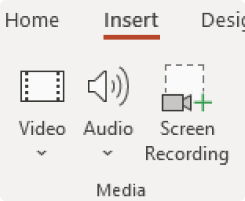
Output folder
After you publish your project, you will get an output folder with the web-ready presentation. This folder also has the same name as the project folder, but it always has the suffix (Published) if it was published to HTML5.
The output folder has an index.html file for launching the presentation and a data folder that stores everything else. In other words, it is a webpage, created by iSpring out of your PowerPoint presentation. The data folder doesn’t store the original project files (e.g., quizzes) and it has a totally different structure than the project folder.
Tip: It’s not recommended to change the contents of the data folder. However, you can edit the index.html file. For example, you can insert a piece of Google Analytics code to track the presentation’s traffic or change the filename without affecting the converted presentation.
Take a look at the diagram below that shows the dependency of the output folders on the publishing option you choose.
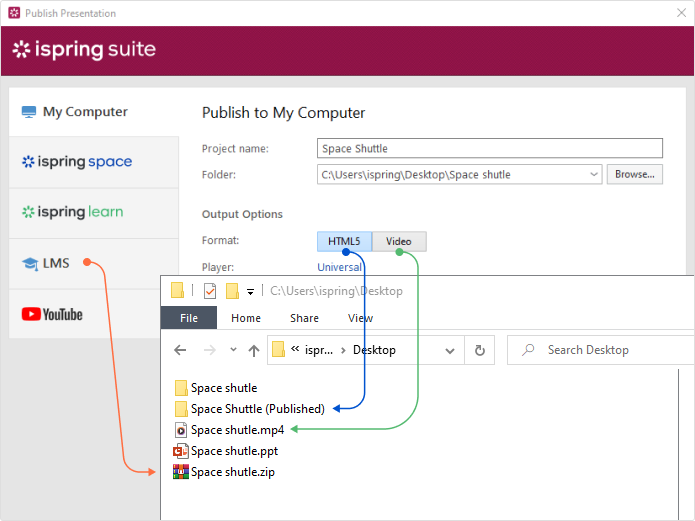
You cannot edit the presentation (course) once it’s published. Using technical terminology, the iSpring conversion is similar to rendering a video project or compiling some code in to a program. Once it’s done, you can’t turn it back to make changes if you don’t have access to the original project.
You can upload the (Published)) folder to your website via FTP or give it to your webmaster to do so. Recommended freeware tool: FileZilla. Read more about sharing published presentations.
Note: As you can see, iSpring automatically creates several folders and files with similar names, including the project folder and the output folder. If you store many projects in one common folder, it will soon be flooded with similar folder names. That’s why we recommend having a separate folder for each project.
Backups and collaborative work
Nothing is as important as making backups of your projects (not just iSpring projects). It will ensure that you don’t lose a bit of your precious work. Also, you can track the version history and share it with your colleagues for collaborative work.
Manual backup
Users of iSpring Suite 11 should follow this path: File → Share → Share iSpring Suite Project → Export Project. To get detailed instructions, click here.
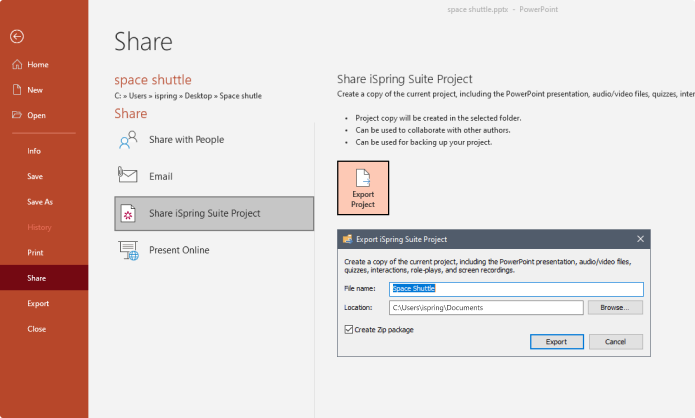
Export is the same operation as if you copied the .pptx file along with the project folder and then added them to a .zip archive in Windows Explorer.
After you get a backup copy of your project, you can:
-
Put it in a project backup storage folder on your computer (create it manually).
-
Send it to a colleague, who will continue working on it in iSpring Suite(e.g., to record or fix a voiceover).
-
Send it to the iSpring Support email if you were asked to share the presentation with the iSpring Help Desk to reproduce the issue.
The repository of your backups may look like this, providing you with version control options as well:
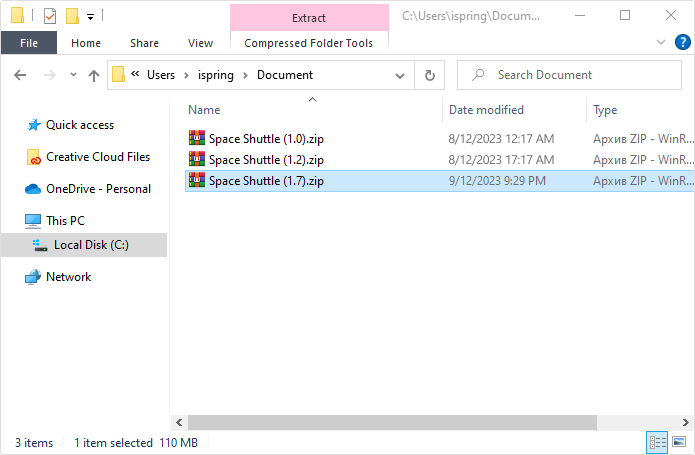
Automatic backup solutions
There are plenty of different solutions that will automate the backup routine for the whole system or selected folders that store the important projects you work on.
Commercial backup software:
Built-in backup options:
- Windows 7 Backup
- Windows 8 File History (similar to Time Machine on Mac)
- Windows 10 File History (similar to Time Machine on Mac)
Related Articles
